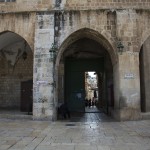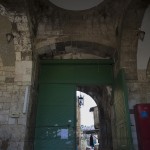Bab AL-Nazir
The second western wall gates of Al-Aqsa Mosque, from the north after the gate of Bani Ghanim. A huge door airtight construction. Rectangular entrance, a height of 4.5 m, and renovated in the reign of King holy Issa 600 e-1203m.
The name of this place is famous for the proportion of the Two Holy Mosques headmaster, and it was a function in Mamluk time and It is given to those who oversees the Al Aqsa Mosque in Jerusalem and the Ibrahimi Mosque in Hebron. It was cold by that name since this beholder was staying in nearby buildings for this section in the Mamluk period, it is also renowned as the “door of the Council”, above this gate is Manjakiyya school, which was the headquarters of the Supreme Islamic Council, during the British occupation, before they turn to the headquarters of the Department of Islamic Waqf in Jerusalem now.
Also, this is Old Testament gate. At first instance, it carried the name Michael then, Aladdin Busairi for its proximity to the bond of Aladdin Busiri which is located outside, In which Prince Mamluk Aladdin Busairi was buried in, then, it was called by the name of ” confinement gate ratio to the prison that was adopted by Turks from Rabat Mansouri, which was located on the left outside of the maximum of this section and closed long ago), it was also called prognostic gate and gate of Rabat Mansouri.“
It is one of the Al Aqsa Mosque three doors that do not open in front of other worshipers to perform the Isha and Fajr prayers in Al-Aqsa Mosque since the beginning of the Zionist occupation of the holy mosque.
this door witness the entry of the first funeral for one of al-Aqsa Martyrs Massacre III (Al-Aqsa Intifada) to pray on him in the Al Aqsa Mosque on 29/9/2000 m, the martyr ( Osama Jeddah) / 20 years, one of the residents of the African quarter which is located outside the gate. (They are the descendants of Africans Mujahedeen who came to liberate Jerusalem from the Crusaders, and they lived next to the maximum besides this gate). Also it displays the door to several attempts by the Zionist occupiers to close it after several clashes with the people of the quarter and Jerusalem in general.





